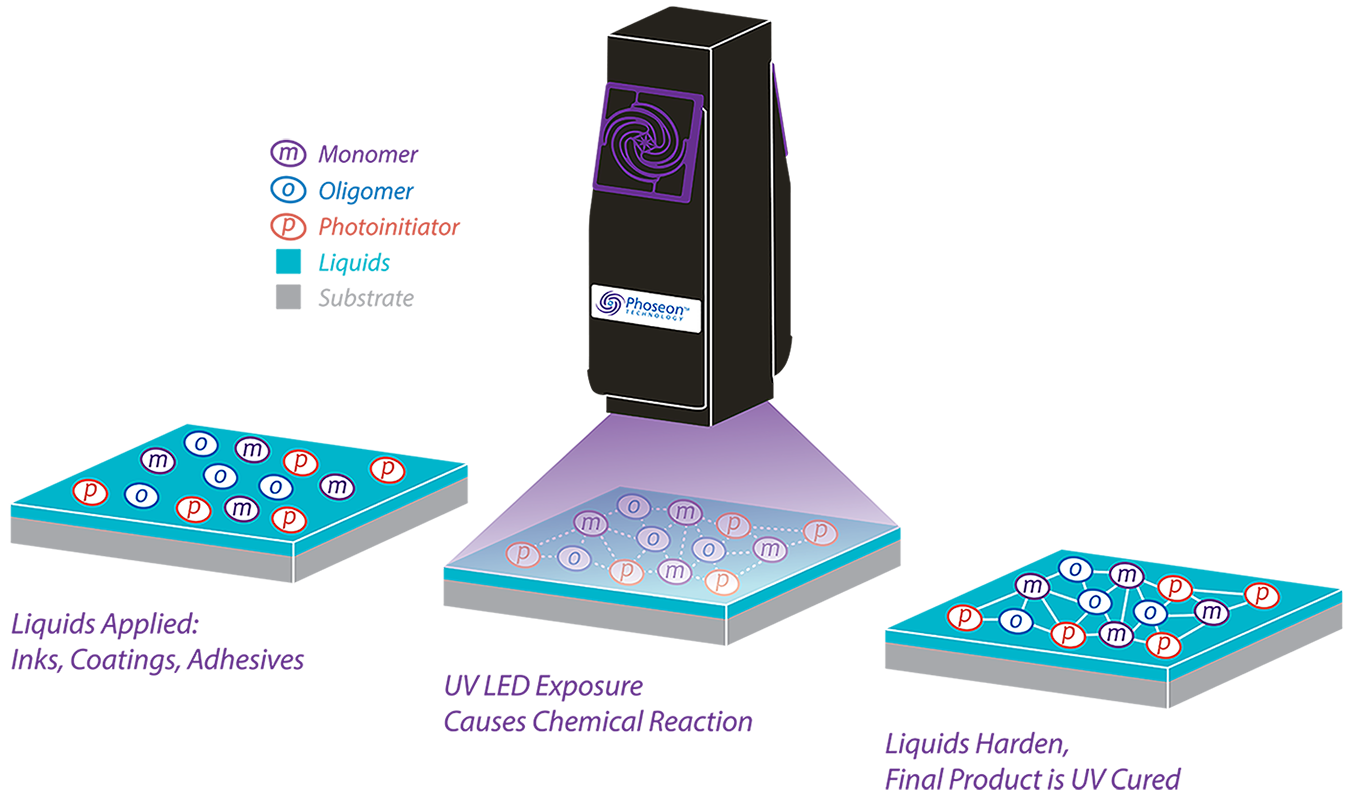Advancements in UV LED Curing
UV LED technology for energy curing has grown significantly in the past two decades.
More and more users have adopted LED curing light sources for printing because they deliver advanced capabilities, improvements in operating economics and environmental advantages. Printers that utilize LED curing technology have reported significant returns on investment in a short period. Users can expand the range of applications they can offer, run equipment at higher speeds, achieve new levels of print quality, use substantially less energy, reduce scrap, reduce VOC emissions in the workplace, and print on lower cost or more environmentally friendly materials.
Since UV LED curing technology began in 2002, there have been significant technological advances in LED efficiency and curing performance. The initial challenges have been met and overcome, allowing rapid technology adoption across a broad array of industries.
Significant Changes in the Past Twenty Years
UV LED curing technology has advanced significantly in the past 20 years. The greatest change in the energy curing market has been the increased amount of ink vendors and raw material providers that offer materials compatible with UV LED technology.
Ink formulation for LED technology has evolved significantly in the past 20 years, and today, all the major ink suppliers offer inks that work well with LED technology. In addition, the availability of low migration inks for UV LED has increased significantly. Material suppliers have responded to the demand and challenge from the printing world to formulate raw materials that absorb energy corresponding to the wavelength of UV LED light sources.
One of the key ingredients in the chemical formulation is a photoinitiator that serves as a catalyst to initiate the polymerization process when exposed to narrow-spectrum UV LED energy. With the continued widespread acceptance of UV LED systems, the availability of suitable base materials continues to grow. The driving factors in the advancement of the chemistry of raw materials are increased capability and cost-effectiveness of commercially available UV LED light sources.
Ink and material vendors formulate for LED (and low migration), and more are developed each year. New resins, monomers, oligomers and photoinitiators have been under development. Not only inks but also coatings and adhesives are now widely available that are either specially formulated for LED or work with both LED and traditional mercury sources.
Customer Requirements for Raw Materials and Equipment
As the use of UV LED has become more widespread, meeting the needs of customers has become more critical. This is particularly the case in packaging, which has its own set of stringent mandates. Ink customers look for reliable, stable UV LED curing products that work with well with their inks.
Since 2002, Phoseon, An Excelitas Technologies Company has been working with all the major ink suppliers and raw material providers to develop UV LED compatible inks and materials. Most ink manufacturers include a UV LED option today, making integration and use of LED even easier. As ink companies continue to develop formulations to optimize both UV LED curing and specific applications, printers can expand the applications they offer to their customers.
Packaging Requirements
When it comes to packaging requirements, UV LED curing technology is ideal for a variety of applications. UV LED curing shows measurable advantages in higher productivity, lower energy usage while utilizing thinner substrates with improved adhesion along with clear environmental benefits. Customers that own UV LED curing printers have discovered they can print on a wide range of materials while printer manufacturers are finding they can reduce the footprint of their equipment with smaller UV LED systems. They can also eliminate large air exhaust ducts since LED systems don’t create ozone and pose fewer heat dissipation challenges than traditional mercury-based curing.
UV LED technology has been shown to be vastly superior in the packaging market for curing black, white, fluorescents, and metallic inks, as well as laminating, cast & cure, and cold foil adhesives. The critical element that each of these has in common is the requirement that UV energy travels through dense pigments, additives, or films without being redirected or prematurely absorbed before full cure is achieved. Due to the physics of light and nature of UV LED output, the depth of penetration is exactly where LED technology excels.
UV LED for Low Migration Packaging
Since 2004, EU Framework Regulation EC 1935/2004 requires low migration for all food packaging. While there are a variety of processes that can reduce migration levels, UV LED curing technology offers superior process stability and consistency, both top requirements for low migration printing. The UV output of LED curing equipment is much more stable over time compared with conventional mercury-based systems. This results in greater process control when used to crosslink inks, coatings, and adhesives in low-migration processes. UV LED systems last longer and can reduce energy consumption by up to 80% compared with traditional arc lamps.
Outlook for UV LED Curing in the Graphic Arts
UV LED curing growth in graphic arts will continue as printers continue to replace solvent-based inks and coatings and other older technologies that are less efficient and environmentally friendly. Today, most digital inkjet OEMs have already adopted LED technology to replace traditional mercury-based lamps for energy curing. Moving into the future, the adoption of LED curing technology in graphic arts will continue to grow for screen printing, flexography, and some areas of offset (web-fed offset or direct-to-container offset) printing because of all the benefits and more stringent mercury regulations.
Are you interested in learning more about our UV LED curing solutions? Please contact us today with your application at www.phoseon.com.


